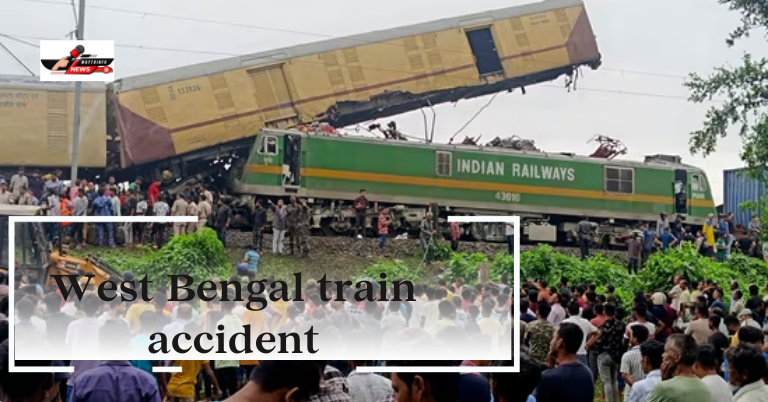West Bengal train accident: Monday morning, a goods train struck the Kanchanjunga Express from behind near Rangapani station, near New Jalpaiguri, while it was traveling from Agartala in Tripura to Sealdah in Kolkata. The impact claimed nine lives and injured forty-one more. Initial results indicate that signal failure and human mistakes may have contributed to the situation.
The freight train’s automated signaling system breakdown caused it to violate speed limits on Monday when it crashed with the Kanchanjunga Express, according to the Railway Board’s preliminary inquiry, which was made public on Monday. Railways has not responded to inquiries about this.
When the automated system fails, railway protocol requires a written authority known as TA 912. This document permits train drivers to pass all red signals due to the signaling defect, as long as they follow strict safety procedures. Both the goods train and the Kanchanjunga Express had been issued TA 912. -West Bengal train accident
Railway rules require drivers to halt for one minute at each faulty signal before proceeding at a maximum speed of 10 kmph. This regulation is referred to as TA 912. Furthermore, if the preceding train has not cleared the signal, they must maintain a 150-meter spacing to ensure adequate stopping time. The goods train driver in this case, however, ignored these critical standards.
The Kanchanjunga Express had passed nine automatic signals with TA 912 and had stopped beyond the ninth signal, waiting for new clearance to proceed further.
Authorization To Cross Red Signals
The Railway Board stated that the driver of the goods train had been authorized to pass all red signals between Rangapani and Chattarhat railway stations due to a defective automatic signaling system. However, the train’s speed exceeded the permissible limit for such situations. The station master at Rangapani issued a TA 912 to the goods train driver, allowing the train to pass nine red signals. This authorization was essential because the automatic signaling system had been malfunctioning since 5:50 am on the day of the accident.
The goods train, GFCJ, left Rangapani at 8:42 a.m. and collided with the halted Kanchanjunga Express at 8:55. The impact caused the derailment of the guard’s coach, two parcel coaches, and a general seating coach of the passenger train. The crash was caused by the goods train driver, who was one of the dead, not following the required speed limits.
The driver of the Kanchanjunga Express followed the safety protocols required during a signalling defect, stopping at each red signal for one minute and proceeding at a speed of 10 km/h. In contrast, the goods train’s driver exceeded the permissible speed limit and collided with the passenger train.
Automatic Signaling System Failure
The driver was permitted to pass all automatic signals between Rangapani and Chattarhat, regardless of whether they were red or caution signs, according to the TA 912 authority letter, which said that the automatic signaling system had failed. The Railway Board stated that under normal circumstances, a train encountering a red signal should stop for one minute during the day and 2 min at night, proceeding with extreme caution at a speed not exceeding 15 km/h in good visibility and 10 km/h in poor visibility.
The freight train exceeded the permitted speed despite these restrictions, which led to a disastrous collision. The Railway Board has not revealed the precise speed at which the goods train was moving.
Rescue operations ended late afternoon, while work to clear the derailed coaches and restore rail service resumed. The North Bengal Medical College and Hospital treated multiple injured passengers, leaving 41 hospitalized, nine of whom were in severe condition. -West Bengal train accident
Official Response
The Commissioner of Railway Safety (CRS) launched an investigation into the reason for the accident. Railway Minister Ashwini Vaishnaw paid a visit to the disaster site, where he oversaw rescue efforts and announced compensation for the victims’ relatives. The families of those who perished will receive ₹10 lakh, ₹2.5 lakh for the grievously injured, and ₹50,000 for those with lesser injuries.
In addition to expressing his sympathies to the victims, Prime Minister Narendra Modi wished for the speedy recovery of the injured.
The train catastrophe in West Bengal is tragic. Sending my sympathies to the families of the deceased. I hope the injured can recuperate soon. Spoke with officials and assessed the situation. Rescue operations are underway to aid those affected. The Railways Minister Shri @AshwiniVaishnaw Ji is also on his way to the scene of the accident,” PM Modi wrote on X.
West Bengal Chief Minister Mamata Banerjee chastised the Railway Ministry for failing to prioritize passenger safety and efficiently deploy the anti-collision system. She claimed that the trains focused on raising fares rather than increasing safety procedures.
The railways have been left without proper guidance. While the ministry exists, the former excellence is absent. They focus only on superficial improvements, neglecting passenger needs. Their priority seems to be increasing fares, she stated. Their grand promises are all talk. There’s also a lack of concern for railway staff, technical aspects, and safety measures. I stand by the railway employees and officers.”
Also Read: Priyanka Gandhi
Governor CV Ananda Bose emphasized the importance of treating the victims rather than playing blame games.

